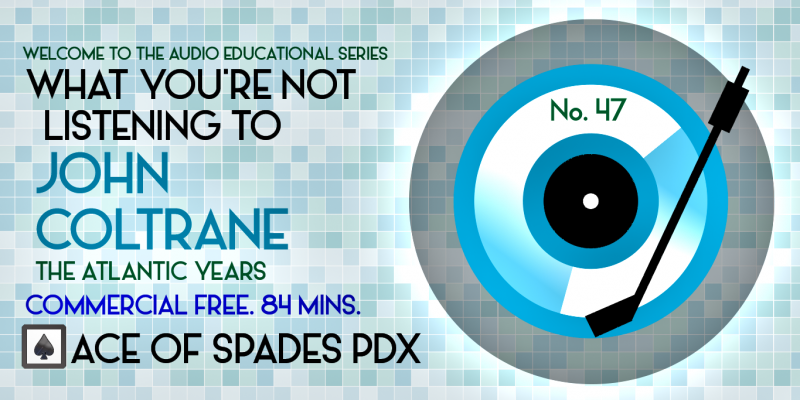Podcast: Play in new window | Download | Embed
Celebrating the brief by highly pivotal brief career of one of the most celebrated Jazz masters during his time on a label founded to bring Black musicians a wider audience. #atlanticrecords #johncoltrane #jazz #bhm2020
1947 was the birth of two incredibly significant moments for Black musicians in the U.S. That year, a Turkish immigrant named Ahmet Ertegun, along with a Jewish dental student from Brooklyn, Herb Abramson, founded Atlantic Records, an independent label specializing in Jazz music, almost exclusively performed by Black artists. It was also that John Coltrane, fresh off his stint during WW2 in the Navy, immersed himself in the local music scene of his adopted hometown of Philadelphia, after playing in bands while in the service.

Atlantic would slowly start to build their reputation as a powerhouse music haven, the first to pay artists royalties and the first to use outside producers. Coltrane, who by the end of the 1950’s had played famously with Miles Davis for several years, including on the latter’s modal Jazz milestone Kind of Blue, had recently kicked his heroin habit and was playing a new type of Soul-influenced Jazz that started to incorporate elements of the avant-garde, influenced by another artist at Atlantic at the time, Ornette Coleman.
“You can play a shoestring if you’re sincere.”
John Coltrane
Coltrane eventually ended up on Atlantic, and using many of the same musicians who played on Kind of Blue, as well as bringing together one of the most exciting ensembles ever assembled, he released Giant Steps in January of 1960. The album could not have been more perfectly named: incorporating hard bop, Soul, blues, modal Jazz and a new type of playing that would be eventually called “Coltrane Changes” that used chromatic thirds as a basis, he literally made an album that almost completely overshadowed his work with Davis just months prior.

It was during the early 1960’s at Atlantic that Coltrane became one of the most important and successful Jazz artists seemingly overnight. Though he only recorded four proper studio albums for the label, Giant Steps, Coltrane Jazz, Olé Coltrane and My Favorite Things, plus enough leftover material to fill four more albums, not including his work with other artists, he left the label that launched his career into the stratosphere for a brand new imprint, Impulse, in 1961.
It was at Impulse that Coltrane would further hone his technical skill and his unique improvisational style, culminating in what many regard as one of the best albums of all time, A Love Supreme. Sadly, we will never know what Coltrane would have accomplished by the 1970’s. He died in 1967 at just the age of 40 from liver disease, often attributed to his years as an addict. He didn’t publicly disclose his condition, and his death came as a shock to many, as he continually played amazing live performances up until just months before his passing.
First Part
- Giant Steps, recorded 1959/released 1960, Giant Steps
- The Night We Called It A Day, 1959, Bags and Trane (John Coltrane and Milt Jackson)
- Like Sonny, 1961, Coltrane Jazz
- My Favorite Things, 1960, My Favorite Things
Second Part
- Blues To Elvin, recorded 1960/released 1962, Coltrane Plays The Blues
- Equinox, recorded 1960/released 1964, Coltrane’s Sound
- Naima, recorded 1959/released 1960, Giant Steps
- The Blessing, recorded 1960/released 1966, The Avant-Garde (John Coltrane and Don Cherry)
Finale
- Olé, 1961, Olé Coltrane
Love to you all.
Ben “Daddy Ben Bear” Brown Jr.
Host, Producer, Audio Engineer, Webmaster, Researcher and Writer
“Copyright Disclaimer Under Section 107 of the Copyright Act 1976, allowance is made for ‘fair use’ for purposes such as criticism, comment, news reporting, teaching, scholarship, and research. Fair use is a use permitted by copyright statute that might otherwise be infringing. Non-profit, educational or personal use tips the balance in favor of fair use.”
